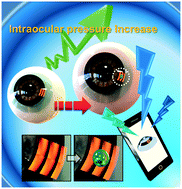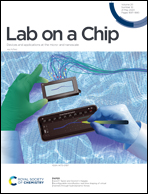Photonic crystal-based smart contact lens for continuous intraocular pressure monitoring†
Abstract
Glaucoma is a very common disease after cataracts and is dangerous enough to cause irreversible blindness. However, often the main symptom of glaucoma is difficult to recognize because it may be absent or appear late, so the risk of blindness is greater. Intraocular pressure (IOP) is a well-known primary factor indicating glaucoma. In this study, we demonstrate a smart IOP sensor embedded in a contact lens that works through visual color changes without an external power source such as a battery or RF-based wireless power transfer. A microhydraulic amplification mechanism is adopted to enhance the range of color change from a photonic crystal (PC)-based flexible membrane whose lattice distance between nanostructures varies according to the morphology changes of an eyeball caused by IOP. The performance of the sensor is quantitatively demonstrated using an artificial silicone eye model for in vitro evaluation and a porcine eyeball for ex vivo verification. It has a limit of detection (LOD) of 3.2 and 5.12 mmHg, which was measured and evaluated using a spectrometer and a smartphone camera, respectively. The results prove that our sensor embedded in the contact lens can continuously monitor the IOP change using color change, and a smartphone camera can be used as a quantitative IOP measurement system in a noninvasive manner without an expensive optical spectrometer.



 Please wait while we load your content...
Please wait while we load your content...